Gila Monster
Heloderma suspectum
This lizard's tail acts as a fat-storage facility!
Advertisement
Gila Monster Scientific Classification
- Kingdom
- Animalia
- Phylum
- Chordata
- Class
- Reptilia
- Order
- Squamata
- Family
- Helodermatidae
- Genus
- Heloderma
- Scientific Name
- Heloderma suspectum
Read our Complete Guide to Classification of Animals.
Gila Monster Conservation Status
Gila Monster Facts
View all of the Gila Monster images!
The Gila monster is the largest lizard in the United States!
The Gila monster is not just the largest lizard in the United States, it’s one of four North American lizards that are venomous. The others are species of Mexican beaded lizards that are found in Guatemala and Mexico. Despite its venom, the Gila monster is a rather lethargic animal and is not dangerous to humans. Found in the Mexican Sonora and the southwestern United States, its conservation status is near threatened.
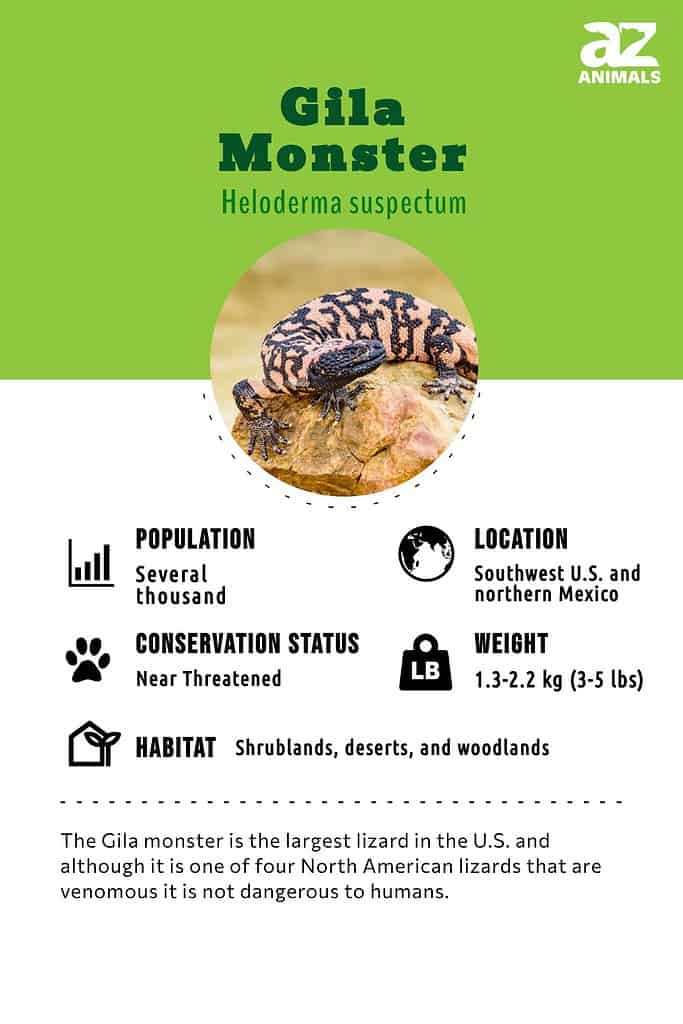
5 Incredible Gila Monster Facts!
- A group of Gila monsters is called a lounge.
- They go into a state called “brumation,” which is hibernation for cold-blooded animals.
- They store fat in their tails. This allows them to fast for months.
- The Gila monster has high “aerobic scope values.” This means they take in and use oxygen very quickly from a resting state to a state of maximum exertion. This allows the normally sluggish lizard to enjoy periods of intense activity.
- The Gila monster has grooves in its teeth through which it injects venom.
You can check out more incredible facts about Gila monsters here.
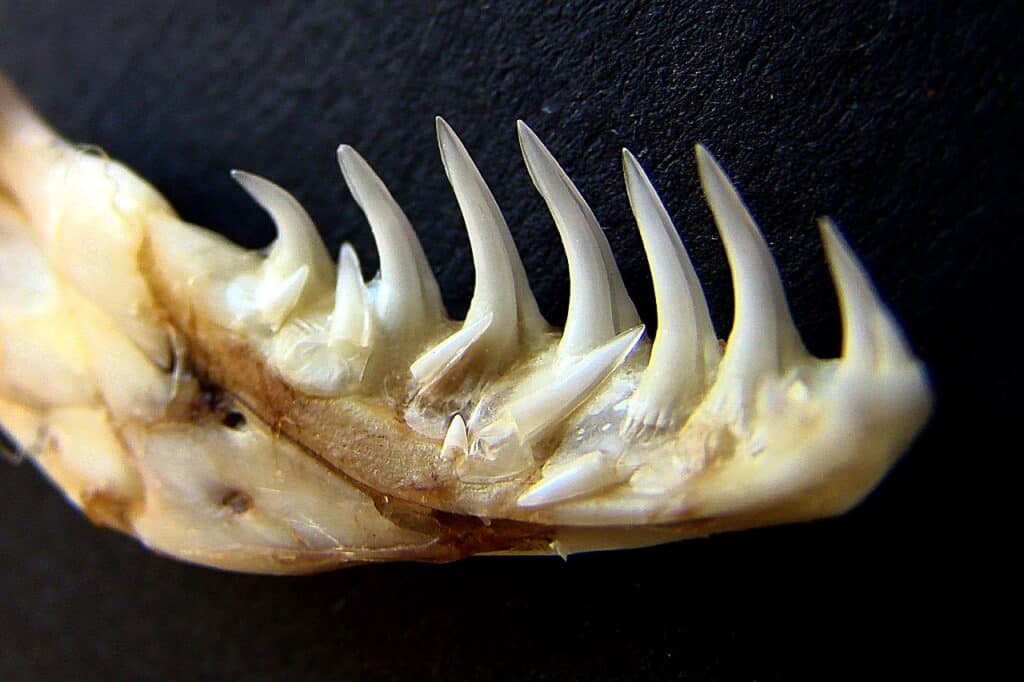
The grooves in a Gila monster’s teeth help spread its venom into its prey fast.
©MonsterDoc / Creative Commons – License
Scientific Name
The Gila monster’s scientific name is Heloderma suspectum. Heloderma, or “studded skin,” comes from two ancient Greek words. “Helos” refers to a nail head. “Derma” is the Greek word for skin. Edward Drinker Cope, the American paleontologist, provided the word Suspectum, for at first the lizard was believed to be a subspecies of the Mexican beaded lizard. It is classified in the kingdom Animalia, class Reptilia, and family Helodermatidae.
This species gets its common name because it was once plentiful in the Gila River Basin of New Mexico and Arizona. As for “monster,” this rather large lizard probably appeared rather monstrous to the people who first came upon it. There was even a myth in the Old West that the giant lizard had poisonous breath, a belief shared by the Apache. In fact, the Gila monster’s venom does have a smell, but the smell itself isn’t toxic.

The Gila monster is named after the area in which it was once abundantly found.
©William Silver/Shutterstock.com
2 Types of Gila Monsters
There are two subspecies of Gila monster:
- Reticulate Gila monster (Heloderma suspectum suspectum): The nominate subspecies has markings that are lighter with dark scales dispersed to create a reticulated, mottled appearance. It can be found in the southern part of the Gila monster’s range.
- Banded Gila monster (Heloderma suspectum cinctum): Typically, this subspecies has scales that are in more complete alternating bands of pink and black. It is present in the northern region and lives mainly in the Mojave Desert.
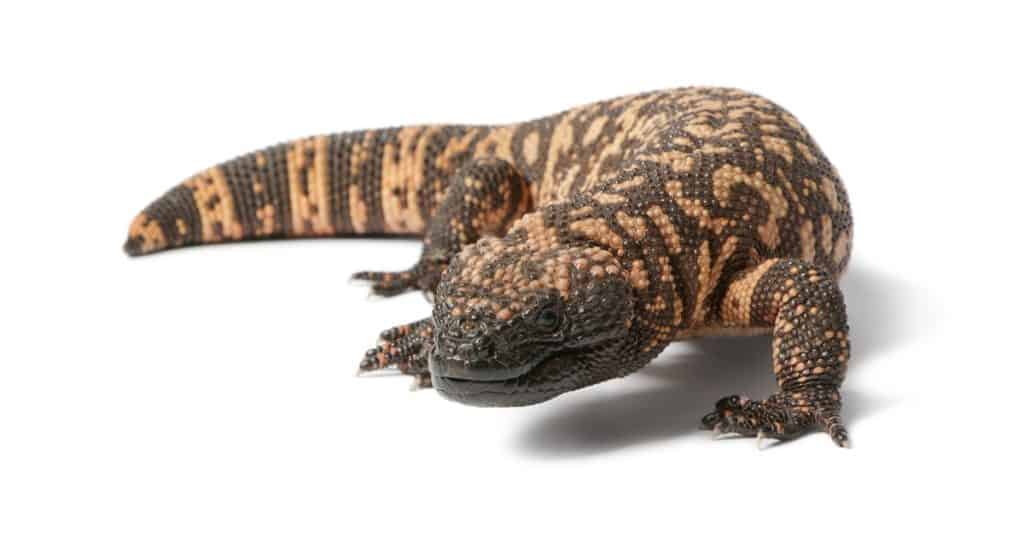
The two subspecies of the Gila monster have different skin patterns.
©Eric Isselee/Shutterstock.com
Evolution and Origins
The Gila monster belongs to the Helodermatidae family of beaded lizards, whose members are thought of as “living fossils” and whose lineage goes back to the Cretaceous period between 145.5 million and 65.5 million years ago. It is a member of the genus Heloderma, whose members’ evolutionary history can be traced to the Miocene about 23.03 million to 5.333 million years ago.
Fossil evidence of the Gila monster’s osteoderms, bony deposits that form scales, discovered near Las Vegas date to the late Pleistocene 8,000-10,000 years ago.
While both are members of the same genus, Gila monsters are different species to Mexican beaded lizards. Four Mexican beaded lizards were once thought of as subspecies of the Gila monster. In 2013 the Chiapan beaded lizard (Heloderma alvarezi), Guatemalan beaded lizard (H. charlesbogerti), Rio Fuerte beaded lizard (H. exasperatum), and Mexican beaded lizard (H. horridum) were recognized as distinct species.
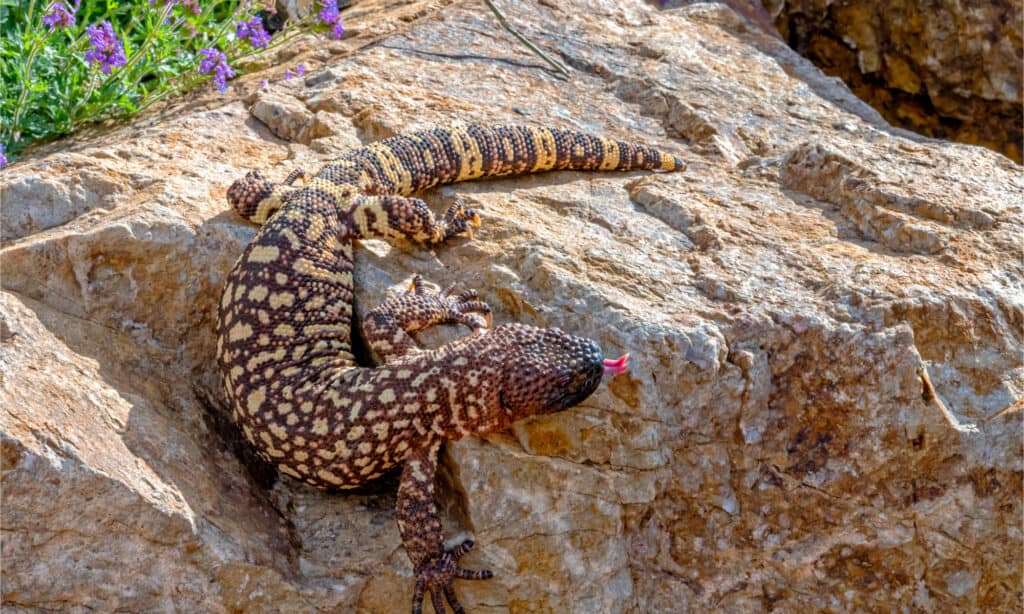
The Mexican beaded lizard used to be considered a subspecies of the Gila monster.
©Evelyn D. Harrison/Shutterstock.com
Appearance
While there seems to be no record of the biggest Gila monster seen, the reptile can reach 22 inches long and grow to weigh 4 pounds and is the largest lizard native to the U.S. It is smaller than its close relative the beaded lizard, native to Mexico and which can reach 36 inches long and weigh nearly 9 pounds. However, the Gila monster is more colorful, with its patterned hide thought to be a type of camouflage that hides the animal from both predators and prey.
It can be difficult to distinguish between males and females, but the heads of males tend to be larger and more triangular in shape.
The Gila monster is notable for its skin. Like other reptiles, its body is covered in scales, but the scales bear small, round bones called osteoderms. These osteoderms are found everywhere but the Gila monster’s stomach, which has patterns of pink or yellow against black. Many parts of the animal are black, including its legs, feet, neck, head, chin, eyes, and tongue.
The patterns on the lizard’s hide grow more complex as it ages, though individuals in the more northern region of its range often retain the pattern they had as juveniles. The scale patterns are unique to each animal.
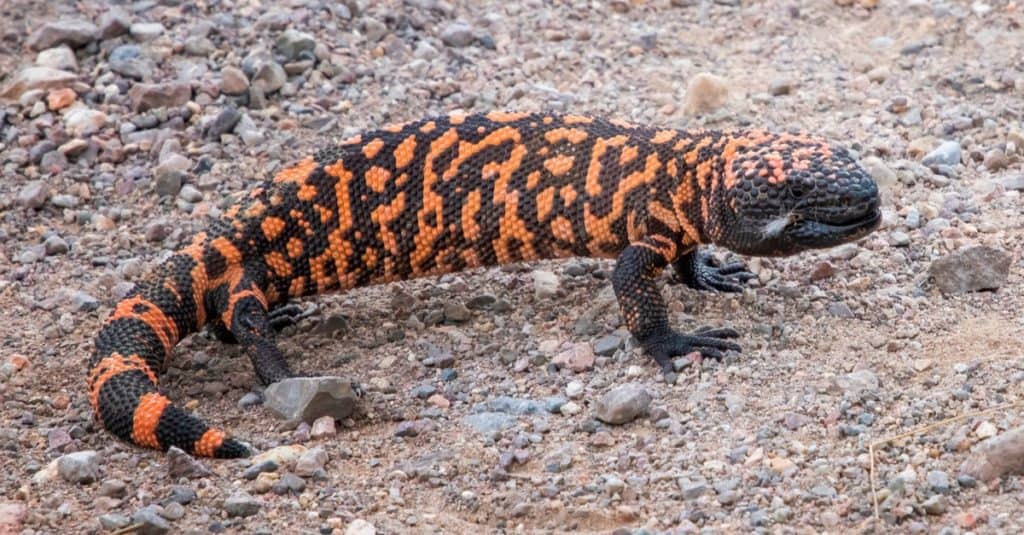
The patterns on the lizard’s skin become more complex as it ages.
©Erin Donalson/Shutterstock.com
Behavior
Like other lizards, the Gila monster sheds its skin as it develops. Females shed theirs in a single large piece in the fortnight before they lay their eggs. Males shed their skin piecemeal, and younger Gila monsters seem to shed regularly.
These lizards are typically solitary, spending a large amount of time secreted in burrows. They will come out to hunt and warm themselves in the sun’s rays. This animal is generally docile, though males have been known to battle it out for over a female during the breeding period. As with Sumo wrestlers, the one who pins the other to the ground wins.
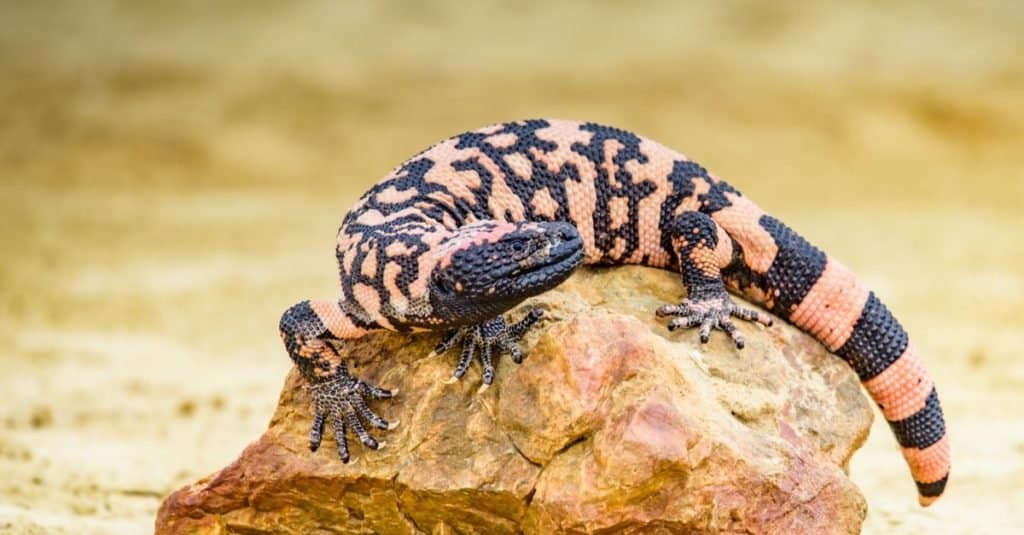
Gila monsters emerge from their burrows to warm themselves in the sun.
©Vaclav Sebek/Shutterstock.com
Habitat
The lizard’s habitat is found in the deserts and dry places of southern Nevada and California’s San Bernardino County. It’s also found in southwestern Utah, southern and western Arizona, the southwest part of New Mexico, and down into Sonora and Sinaloa in Mexico. Elevations range from sea level to 4921 feet. Though it is a creature of the desert, the lizard needs to live near a steady supply of water.
During the dry season, the lizard emerges from its shelter in the mornings. It may emerge at night instead in summer months when the air is warm but once the dangerously hot sun has set as it needs to maintain a body temperature of around 86 degrees Fahrenheit. However, if it gets too hot, the lizard can lower its temperature by emitting water through its cloaca, which is a ventral opening through which it excretes and reproduces.
The lizard doesn’t migrate but moves from one shelter to another every few days. Besides underground burrows, these shelters can be crevices and thickets.
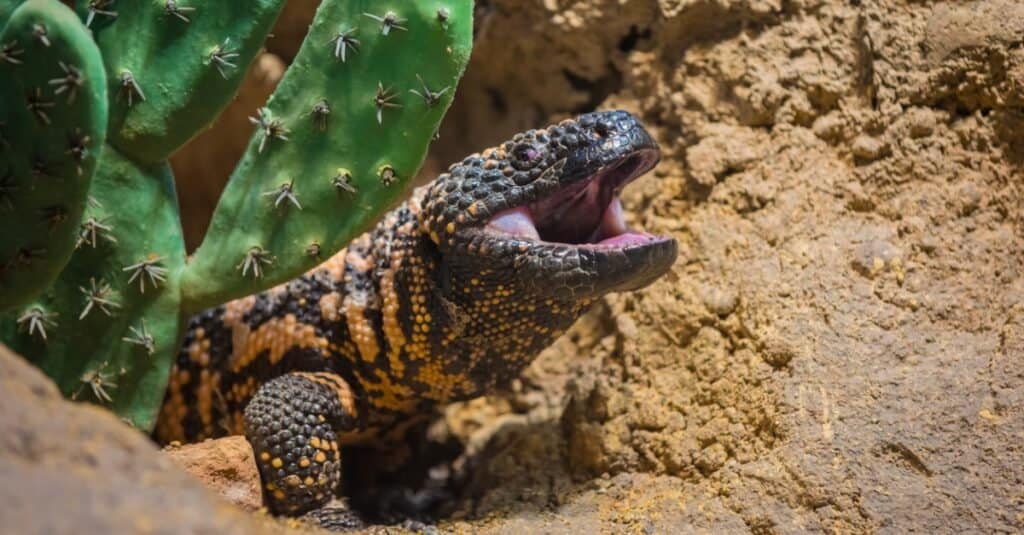
The Gila monster is found in desert habitats.
©iStock.com/kwiktor
Diet
The animal isn’t fussy when it comes to food and can survive for months without eating, only needing a few meals a year to stay healthy.
The lizard’s diet includes the young of mammals such as mice, ground squirrels, and rabbits. It also eats insects, frogs, eggs, snakes, other lizards, and small birds. The lizard is not above eating carrion. Of course, it is a rather slow animal which can impact what it’s able to eat at any given time.
Young Gila monsters are capable of ingesting prey that is half their body weight in one sitting. Adults can ingest prey that’s about a third of their body weight.
The animal finds prey through an excellent sense of smell and like a snake has a tongue that is forked and can detect molecules of a scent. The tongue sends the molecules to the Jacobson organ, whose opening is at the top of the lizard’s mouth. The lizard can then tell what kind of prey it is pursuing. The Gila monster has no problem climbing trees, cacti, or walls in search of a meal.
Like a snake, the Gila monster can swallow its prey whole, sometimes while it’s still alive. It will crush the prey to death if it’s too large to swallow. Right after it eats, the Gila monster will search for more prey.
What Foods Are Bad for the Gila Monster?
A Gila monster that’s kept in captivity shouldn’t be given raw, store-bought eggs because of the risk of salmonella poisoning. They should be given water to drink, but it should not come in so large a container that it tempts the lizard to bathe in it. The animal might be so enamored of a soak that it won’t want to do anything else!
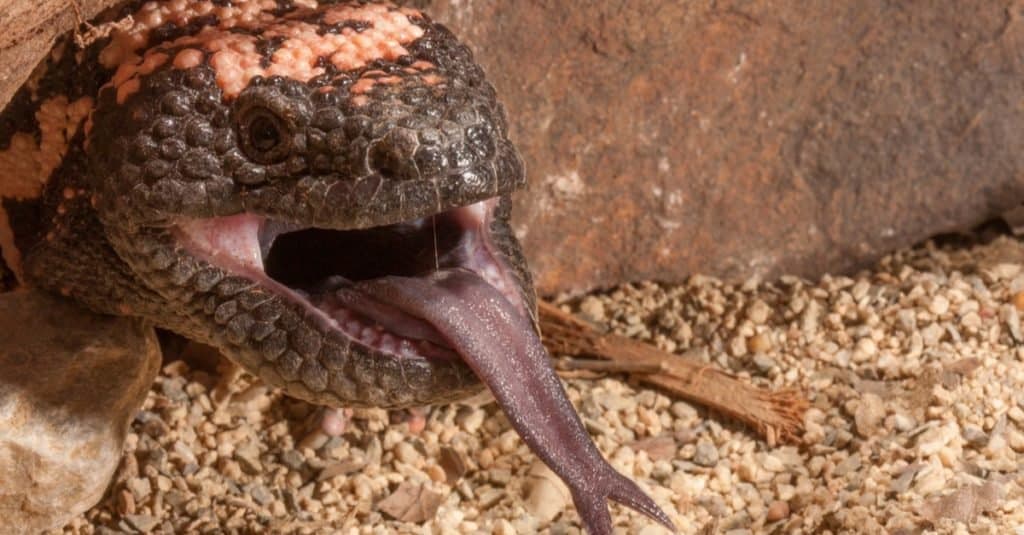
The Gila monster uses its forked tongue to detect the scent of its prey.
©K Hanley CHDPhoto/Shutterstock.com
Predators and Threats
Gila monsters are most at risk for being prey themselves when they’re young. Hatchlings seem to be the favorites of snakes, especially the king snake. Older lizards are taken by large birds of prey and coyotes. Since the lizard doesn’t move very quickly, it is easy for predators to simply pounce upon one if it is vulnerable in an open area and can be subdued quickly. A badger might go so far as to dig a Gila monster out of its burrow.
Unfortunately, the greatest threat to the Gila monster is humans. Because of human encroachment and habitat destruction, the population of the lizards is declining. Some people collect wild Gila monsters for pets, even though it is illegal to do so in some states.
Drought, probably exacerbated by climate change, is another reason that Gila monster populations are declining.
Gila monsters were often relocated to other areas when the land they were on was needed for housing or agriculture. They often returned, even if they were relocated miles away. More and more, humans are being encouraged to simply live with the Gila monsters they might find in their neighborhood, as the giant lizards really aren’t dangerous.
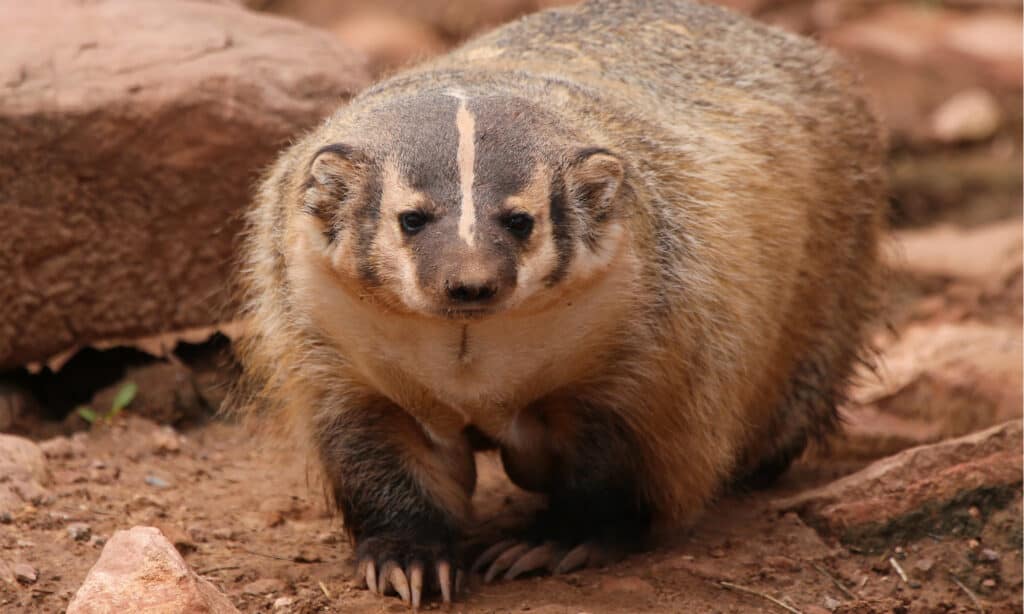
A badger will prey upon a Gila monster and dig it out of its burrow.
©Steve Boice/Shutterstock.com
Reproduction, Babies, and Lifespan
The Gila monster is sexually mature at age 4 to 5 years. Its mating season starts in April or May when food sources are most abundant. The male searches for a female, flicking out his tongue to catch her scent. When he finds a potential partner he’ll use his chin to rub her back and neck and his hind legs to hold her in place. If she doesn’t want to mate, she’ll bite him and remove herself from his embrace. If she is receptive, she’ll raise her tail, and he’ll position his tail under hers to make sure their cloacae come into contact. The contact can last from 30-60 minutes, though some matings could be as short as 15 minutes and or as long as 2.5 hours. Males mate with multiple partners if the females are willing.
The female Gila monster’s pregnancy lasts for about two to three months, then toward the end of summer, she will use an underground burrow such as that belonging to a ground squirrel to lay the eggs. The eggs are not incubated or guarded and will hatch in October. Baby Gila monsters, known as hatchlings, are born measuring a little over 6 inches in size and capable of biting and injecting venom to defend themselves. They go into brumation (a state of inactivity) as newborns, living off their internal yolk sac and gaining strength for months before becoming active around May.
The Gila monster has been known to live for 40 years in the wild. In captivity, their lifespans are shorter, generally around 8 years, though at least one lizard has been recorded as living for 20 years.
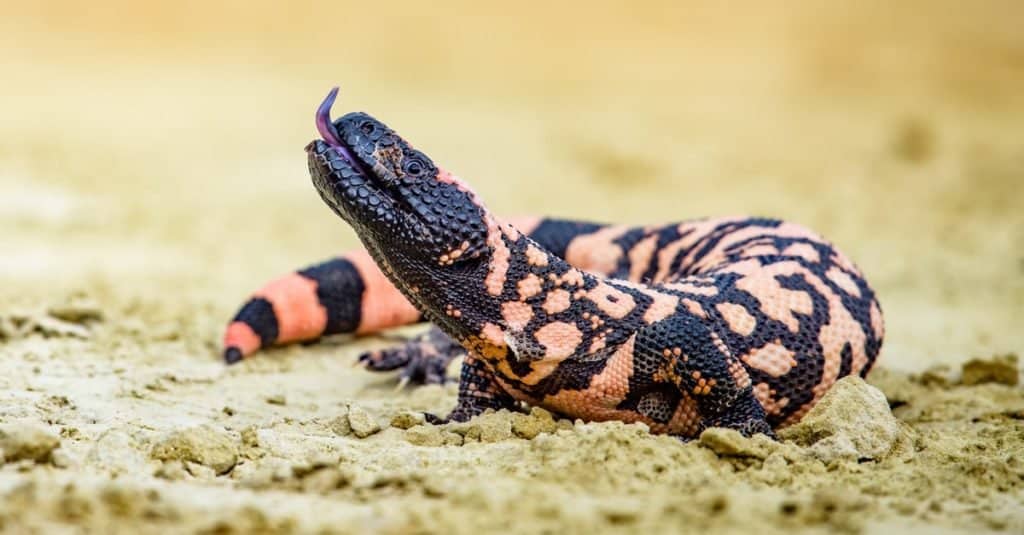
The Gila monster uses its tongue to catch the scent of a female to mate with.
©Vaclav Sebek/Shutterstock.com
Population
There are several thousand wild Gila monsters, with between 450 and 800 animals in Utah alone. The animal is so secretive it’s hard to arrive at a definitive number. Still, the numbers are declining, and the Gila monster is considered Near Threatened by the International Union for Conservation of Nature. This means that though the animal isn’t critically endangered, endangered, or vulnerable, it’s feared that it will achieve one of those statuses soon. Nevada, Utah, and Arizona protect the Gila monster.

The IUCN’s Red List classifies the Gila monster as Near Threatened.
©Tobias Arhelger/Shutterstock.com
Gila Monster in the Zoo
There are many zoos in the United States that have Gila monsters, though they are notoriously hard to breed in captivity. They include the:

The North Carolina Zoo houses Gila monsters.
©ZikG/Shutterstock.com
Gila Monster FAQs (Frequently Asked Questions)
Are Gila monsters herbivores, carnivores, or omnivores?
Gila monsters are carnivores, meaning they eat other animals.
What kingdom do Gila monsters belong to?
Gila monsters belong to the kingdom Animalia.
What class do Gila monsters belong to?
Gila monsters belong to the class Reptilia.
What phylum to Gila monsters belong to?
Gila monsters belong to the phylum Chordata.
What family do Gila monsters belong to?
Gila monsters belong to the family Helodermatidae.
What order do Gila monsters belong to?
Gila monsters belong to the order Squamata.
What type of covering do Gila monsters have?
Gila monsters are covered in scales.
What genus do Gila monsters belong to?
Gila monsters belong to the genus Heloderma.
In what type of habitat do Gila monsters live?
Gila monsters live in shrublands, deserts, and woodlands.
What is the main prey for Gila monsters?
Gila monsters prey on eggs, small mammals, birds, and reptiles.
What are some predators of Gila monsters?
Predators of Gila Monsters include humans, coyotes, and birds of prey.
How many eggs do Gila monsters lay?
Gila monsters typically lay 8 eggs.
What is an interesting fact about Gila monsters?
A Gila monster’s tail acts as a fat-storage facility!
What is the scientific name for the Gila monster?
The scientific name for the Gila monster is Heloderma suspectum.
What is the lifespan of a Gila monster?
Gila monsters can live for 20 to 30 years.
How fast is a Gila monster?
A Gila monster can travel at speeds of up to 15 miles per hour.
What is a Gila monster?
A Gila monster is a type of lizard. It is the largest lizard in the United States and is unusual because it is venomous.
What do Gila monsters eat?
Gila monsters eat a variety of animals, but since they’re slow-moving, they prefer eggs and baby animals.
Where does the Gila monster live?
The lizard lives in the arid areas of the American southwest and northern Mexico.
What eats Gila monsters?
Gila monsters are eaten by carnivores such as coyotes, birds of prey, and badgers.
Can a Gila monster kill a human?
There are no records of a Gila monster killing a human.
How poisonous is a Gila monster?
Gila monsters aren’t very venomous, but their bite is notoriously painful. Basically, the reptile will clamp its jaws on a person, and chew the venom into the wound.
Can you have a Gila monster as a pet?
There are places where a person can legally own a Gila monster as a pet, but it needs a great deal of care and careful handling.
Why is it called a Gila monster?
It’s called a Gila monster because it’s from the Gila River Basin, and indigenous people and settlers sometimes considered it a monster.
What is the difference between Gila monsters and Mexican beaded lizards?
As the only species in the Helodermatidae family, Mexican beaded lizards and Gila monsters have so much in common. However, there are some differences between both reptiles. The most remarkable distinguishing characteristics are their size, habitat, and combat behaviors.
What are the differences between a monitor lizard and a Gila monster?
The greatest differences between a monitor lizard and a Gila monster include their size, location, and appearance.
Thank you for reading! Have some feedback for us? Contact the AZ Animals editorial team.
Sources
- Docs Reward, Available here: http://www.docseward.com/
- Live Science, Available here: https://www.livescience.com/58379-gila-monster-facts.html
- Animal Diversity Web, Available here: https://animaldiversity.org/accounts/Heloderma_suspectum/
- Wikipedia, Available here: https://en.wikipedia.org/wiki/Gila_monster
- Reptiles Magazine, Available here: https://www.reptilesmagazine.com/gila-monsters-and-beaded-lizards/
- Arizona-Sonora Desert Museum, Available here: https://www.desertmuseum.org/kids/oz/long-fact-sheets/Gila%20Monster.php
- Petful, Available here: https://www.petful.com/other-pets/gila-monster-care-guide/
- Science Direct, Available here: https://www.sciencedirect.com/science/article/abs/pii/S0006320703002969
- Smithsonian's National Zoo & Conservation Biology Institute, Available here: https://nationalzoo.si.edu/animals/gila-monster

















